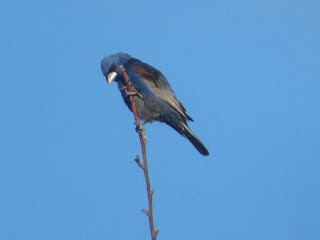The more things change, the more they stay the same. Most insects and plants in the Corrales Bosque are preparing their affairs to get ready for the winter months ahead. Whether it's seeds, spores, eggs, or dens, everything is getting ready to turn over yet another year according to the directions laid down in each organism's DNA.
Most insects are mating, but every species does things slightly differently. Because the male dies after mating, each male does not hold back in its mating effort.
Leaf footed bugs overwinter and lay eggs in the spring and summer. Apparently, many are active right now and many eggs are hatching. They are not really a pest but they do have repuginatorial glands. Many insects have these glands and almost all of them are called stink bugs.
Ant swarms occur on a warm day after a rain. Swarms over bodies of water are relished in large numbers by most fish and they are pretty easily to catch during this time by fly fishing because they are brief and the trout are not choosy when in a hurry.
The monsoon season has been good this year, but the extra water on recent burn scars has increased river runoff. This is a natural phenomena in the west, but is seen more now that houses are being built in undeveloped areas, and worse, along river banks that are inherently unstable.
Mushrooms are a bizarre and fascinating world all of their own. The range of fruits go from deadly poisonous through the whole spectrum to absolutely delicious. These are oyster mushrooms I found in the mountains. There is a lot more to their biology than the culinary arts. For the record, these are delicious.The monsoon season has been good this year, but the extra water on recent burn scars has increased river runoff. This is a natural phenomena in the west, but is seen more now that houses are being built in undeveloped areas, and worse, along river banks that are inherently unstable.
While I would never eat any mushroom foraged in the wild, I especially would not eat one I can't identify, like this one. I still can appreciate the design and colors of this mycelium, however.
Turtles can also be a diverse and confusing group of animals. Many species are not slow or even vegetarian. The large tail seen here is a give away that this is a common snapping turtle. Their temperaments vary from timid to feisty and they should always be left alone. They are more dangerous the bigger they get. This one is likely an experienced female looking for a soft sandy bank in the sun to lay her eggs. Most turtle eggs get dug up by dogs or raccoons very soon after they are laid,
Thick weeds annoy bystanders and gardeners, but they give cover to many animals and the insects they harbor are a boon to the many small birds that are coming back to the Bosque in the autumn.
Dragonfly are around in large numbers and with great diversity. Right now their eggs have hatched and the larval stages are actively hunting in the shallow water. These underwater hunters are nowhere near as pretty as this turquoise colored adult.
In late summer we see many different crayfish species. This one is the most invasive; a Lousiana red swamp crayfish. Able to eat plants or meat, hunt or scavenge, breath in water or air they are versatile creatures that have adapted well to farming activity and a life in the ditches. They can live in both fast, or slow flowing water. They can often be seen traveling up the acequias during low flow between irrigation pulses.
Birds like this grosbeak use migration to adapt to their environment. Humans have made the migration unpredictable and stressful, with wind turbines, glass windows, and domestic cats. While some birds such as pigeons thrive, most others are facing slow declines. Hummingbirds have adapted to feeding from bird feeders, but that is because they can no longer find predictable wild flower meadows to forage in during their travel. They have become a semi-domesticated animal, just like the rock pigeons of the city.
Coyotes are certainly not domesticated everywhere. They have never been the apex predators many people think them to be. They are still actively hunted by mountain lions in the bosque but their numbers are no longer controlled by being hunted by the larger wolves. They have a very varied diet and live well with humans because they eat fallen fruits and many small mammals such as mice and gophers found around human buildings. Living in communities they use well hidden dens to raise their young. Like this one those young coyotes then spread out over the countryside, close enough to humans to be protected from other carnivores that might hunt them. They are opportunists that eat whatever is the easier to find. Don't leave pets, or pet food outside (or drinking water) and they will go somewhere else to forage.
A chrysalis like this one will overwinter and hatch as soon as the weather warms back up next spring. By overwintering, these insects are prepared to be ready extra quickly when conditions are right. This chrysalis is basically a large insect seed ready to go come spring. By mating as soon as conditions are right, they can survive harsh conditions such as human gardening practices.














I appreciate your blog - I can’t get out to see it myself so you help keep me connected.
ReplyDeleteGreat to continue learning about our beautiful area- thank you!
ReplyDeleteGreat information, thx for posting !
ReplyDelete